
Are you wondering what the trends within telecommunications hiring are?

Where telecommunications stands right now
This is, almost undeniably, the most interesting time in telecommunications industry history.
The industry is mature and remains highly competitive. The immediate future of wireless is clearly in the total connectivity potential of 5G technology, with organizations such as Verizon launching fully-virtualized 5G cores within 20-24 months. Verizon, like most operators, initially embraced “non-standalone” design using a 4G network to handle tasks in order to launch commercial services more quickly.
While the 5G potential is clear — streaming video to ultra HD television screens, virtual reality applications, real-time online gaming and smart home applications — and will allow communication service providers (CSPs) to move up the value chain, the present is a bit less clear.
Revenue growth has been in the low single-digits for years, largely because services are sold at a flat rate. The flat rate model comes from the earliest days of scaled telecommunications, but has persisted to this day.
You’d expect more revenue growth because of the massive jumps in data consumption desire. Consumer IP traffic is expected to have a 27% CAGR between 2017 and 2022, while mobile data’s CAGR will be 47% in the same time span.
But additional concerns are all over the market. Over-the-top (OTT) companies are increasingly taking a bigger slice of the pie, with McKinsey estimating businesses like Skype, WhatsApp, and WeChat will own 40% of messaging, 25% of voice fixed, and 5% of voice mobile in 2019.
Then bring in cloud adoption. The trend line in the industry is in decoupling hardware from software, but when that happens, it doesn’t necessarily mean the resulting software is cloud-facing. When AT&T speaks of being “75% virtualized by 2020,” that doesn’t mean 75% will reside in the cloud.
For 10 years, the global weighted Average Revenue Per User (ARPU) has declined 34%. Mobile penetration seems to have peaked, predicted at a 2% CAGR from 2017-2022, while overall CSP revenue will only be about 3% CAGR in that time frame.
What telecommunications needs to do next is:
- Embrace digital transformation
- Become more customer-centric
But these issues above, specifically about the slow rate of cloud adoption and the tendency to silo data, are holding back telecommunications companies from embracing this customer-centric, digitally-driven model. The crux of what’s happening for telecommunications companies right now is that they need to reinvent themselves as relevant businesses for the digital economy.
Think about it in FANG terms: Facebook, Amazon, Netflix, and Google. Those companies are tremendous at customer-driven, personalized approaches. Facebook shows you the content you want to see; Amazon shows you what you want to buy. Netflix shows you what you want to watch, and Google finds you anything you need to know more about. It’s because all those companies are designed, tech-wise and personnel-wise, around the end customer.
Now think: when’s the last time you experienced that type of personalized experience from your phone carrier? Right. It may have been a while.
It’s time for the telecommunications reinvention
This reinvention is going to happen because of a mix of:
- 5G technology
- Cloud
- Better customer experience across multiple touchpoints
As telecommunications reinvents itself, Deloitte has estimated the industry might add 370,000 new jobs in just five years. We’ve even heard theories that job growth in telecommunications might be so rapid post-5G that it will start to become a true “A-Player” industry, similar to finance in the 1990s and tech across the last decade.
That changes what you need to do on the hiring side. If you’re in telecommunications and need to hire at this level of scale, you absolutely need to be considering artificial intelligence recruiting to help you with high-volume searches. You need to simplify and streamline your candidate experience — good communication, multiple touchpoints — to make sure you’re not alienating the best people in the market. If 5G opens up possibilities for telecommunications that we haven’t even considered yet, and it might, that’s going to revolutionize how hiring is done in the space. It’s time to revolutionize how you think about hiring for telecommunications now, to stay ahead of that curve.